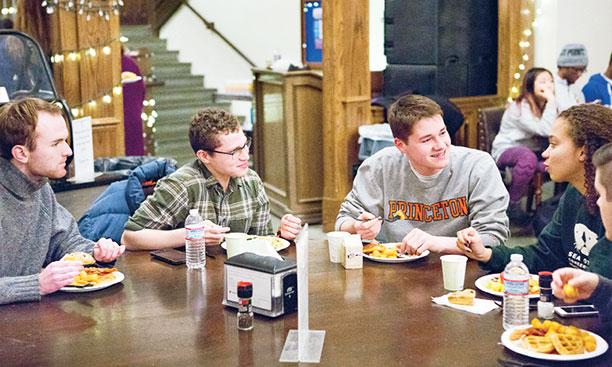
Popular debates about higher education often focus on affordability and value. Are students running up too much debt as they earn degrees? And do their degrees enable them to succeed after they graduate? Thanks to the generosity of our alumni, Princeton has a terrific story to tell about both affordability and value. In 2001, Princeton pioneered an all-grant, no-loan financial aid program that has made us one of the most affordable places in the country to attend college.
The numbers are extraordinary and bear repeating: 60 percent of today’s student body qualifies for financial aid. For those on aid, the average grant covers 100 percent of the tuition price. As a result, more than 80 percent of recent Princeton seniors graduated with zero debt. For the roughly 16 percent who borrow to support a summer experience or other option, the median debt at graduation is less than $6,000.
Whether students are on financial aid or not, the return on investment from a Princeton education is outstanding. Indeed, Money Magazine, which performs a sophisticated analysis of educational outcomes and alumni success, this year ranked Princeton as the top value-for-money in American higher education. Any set of ratings should be taken with a grain (or shaker) of salt, but I cannot resist mentioning that only one other Ivy League university made the top 10: Harvard, which came in 10th.
At Princeton and its Ivy-plus peers, the problem today is not affordability or value. The problem is scarcity. As anyone who has gone through the admission process recently—or watched a child go through it—knows, there are simply not enough places to accommodate all the talented students who would benefit from a first-rate education.
Last year, Princeton turned down nearly 94 percent of the students who applied—more than 29,000 individuals. The vast majority of these applicants were superb, and many of them would have flourished here.
I love the students on our campus. They are splendid and inspiring young people. But I know that we are turning down many more students whom I would be thrilled to have at Princeton.
That is why I am so pleased by the trustees’ decision to authorize fundraising to support increasing the size of the entering class by 125 students. This 10 percent increase— the same expansion we undertook when we built Whitman College a decade ago—would allow us to accept more students from all backgrounds. It would enable us, for example, to continue increasing the socioeconomic diversity of our student body, while also adding to the wide variety of other students, including highly qualified alumni children, who contribute so substantially to Princeton today.
When I talk with alumni about expansion, most share my enthusiasm: they want more students to have the transformative experience that meant so much to them. They also want to be assured, however, that Princeton maintains its distinctive sense of community. How big can Princeton get, they ask, before it ceases to be Princeton?
I share that love of Princeton’s unique character, and I expect there is a limit, somewhere, beyond which Princeton should not grow. I am confident, however, that we can add 125 students per class without getting anywhere close to that limit. Our last expansion proved that, if we grow carefully, we can maintain and even strengthen the bonds that tie Princetonians together. I see that strength vividly in our youngest and largest classes, whose vibrant connections to one another and this place have them “clearing the tracks” to return to Reunions in numbers that are awesome even by the standards of Old Nassau.
A new residential college will be essential to our next expansion, as it was to our last one. I hope we will be able to construct two new residential colleges rather than only one. By building two, we would not only provide the beds needed to house additional students, but also enable the University to take some existing housing offline for renovation. In addition, the new colleges would give us opportunities to consider arrangements and innovations that would further improve the Princeton experience.
The most likely site for the new colleges would be south of Poe and Pardee fields—a choice that would, as happened with Whitman College, require us to relocate athletic facilities that currently support outdoor tennis, softball, and soccer. We hope these new facilities will benefit from enhancements that would be difficult to achieve in their current locations.
As I contemplate Princeton’s next expansion, I am often reminded that growth is itself one of the traditions that define and enliven our alma mater. In our early days, when we were the College of New Jersey, my predecessor John Witherspoon, his student James Madison, and the entire college were collected together in Nassau Hall. We have grown with the country and the world ever since, creating a beautiful, cherished campus while preserving a genuine intimacy rare in higher education. I look forward to working with all of you to help Princeton extend to more young people the opportunities that mattered so much in our own lives, and the lives of those who preceded us.
